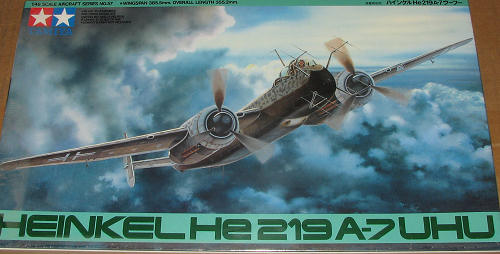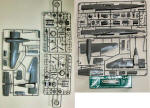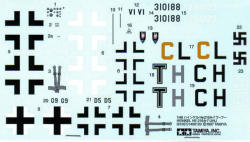
Tamiya 1/48 He-219A-7 Night Fighter
| KIT #: | 61057 |
| PRICE: | $54.00 MSRP |
| DECALS: | Two options |
| REVIEWER: | John Doerr |
| NOTES: | 120 parts and a nose weight |

| HISTORY |
Although production of 100 began, Milch tried to kill the entire program. Milch did manage to halt production. But hen his favored Junkers design lagged in development production was resumed. The order was increased to 300 of the fighters of which only 268 were completed.
The He 219 was fast, with a top speed of 360 knots and maneuverable. It was heavily armed, the usual combination being two 20-mm and four 30-mm cannons. It was an independent aircraft, and after being fed into the bomber stream by ground control would hunt on its own with the speed to hunt and catch several aircraft on each sortie. It is a matter of conjecture as to what would have happened had the He 219 been ordered immediately into mass production.
| THE KIT |
 The
kit is what one would expect from Tamiya.
The kit contains five medium gray trees and one clear tree.
Tree D containing the parts for the engines and main landing gear is
duplicated.
They come in a sturdy lid and tray type box and each tree is bagged separately
except for the D trees, which are both in the same bag.
The
kit is what one would expect from Tamiya.
The kit contains five medium gray trees and one clear tree.
Tree D containing the parts for the engines and main landing gear is
duplicated.
They come in a sturdy lid and tray type box and each tree is bagged separately
except for the D trees, which are both in the same bag.
The pieces have petite recessed details except for those, like the cockpit, where raised detail is required and preferred and are clean and flash free. I could rave on about my initial impression when I opened the box, but any of you who have built any of the recently released Tamiya kits know exactly what I am talking about. One simply runs out of superlatives.
The initial impression of the detailing in the cockpit is that aftermarket details would be superfluous. Yes, it can be improved on, but not by much. Careful attention to detail and a good paint job will make the cockpit shine.
The molding is precise and many pieces, like the radar antenna, are very thin and delicate. The only thing I spotted that I could possibly criticize is in the flame dampers. Each of the dampers is composed of three pieces, front, center and back. They are tubular in shape and have a circular cross section. The center section has a hollow opening along the side that faces the engine nacelle, but I seriously doubt that this will even show.
Decals
 If there is
a failure with a Tamiya kit it lies in the decals.
Their decals are often thick, stiff and have rarely yielded to any
solvent weaker than concentrated hydrofluoric acid.
The decals are printed cleanly and in register and include the gauge
faces on a clear backing and include both the pilotís and radar operatorís
belts.
Also included are the swastikas for the tail fins.
I shall try them, but fortunately I have enough aftermarket decals on
hand to replace most of the markings.
If there is
a failure with a Tamiya kit it lies in the decals.
Their decals are often thick, stiff and have rarely yielded to any
solvent weaker than concentrated hydrofluoric acid.
The decals are printed cleanly and in register and include the gauge
faces on a clear backing and include both the pilotís and radar operatorís
belts.
Also included are the swastikas for the tail fins.
I shall try them, but fortunately I have enough aftermarket decals on
hand to replace most of the markings.
Instructions
The instructions are standard Tamiya international pictorial. I scrutinized the set carefully and felt satisfied that I found no ambiguities at all concerning the construction. They include a separate sheet with a profile for each of the options, one of which is full size.
| CONCLUSIONS |
Although this kit has been out for a while, he only thing I can say about this kit is if you like the Luftwaffe and have not gotten it, then get one soon. The only drawback is the price. I have spent more, though, on worse kits, then buying all the after market details to fix it up.
| REFERENCES |
http://www.geocities.com/lastdingo/aviation/he219.htm
http://www.xs4all.nl/~fbonne/warbirds/ww2htmls/heinhe219.html
October 2008
I should like to thank Peter O. Johnson and my partner Susan for their help in reviewing and editing
If you would like your product reviewed fairly and quickly, please contact me or see other details in the Note to Contributors.